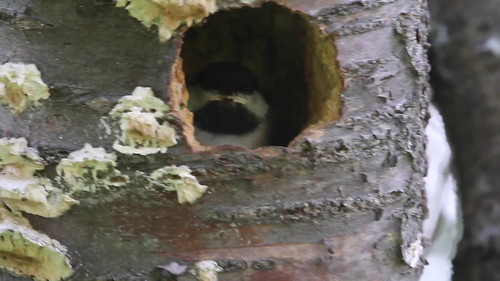On Wednesday this week, my neighbor Jeanne Tonkin told me that she had found the chickadee nest of the male chickadee we’ve been tracking. I went straight over and got hundreds of photos. We got some good looks at one or two nestlings that had worked their way up to peek out the entrance hole, and they appeared well feathered out—I thought they had to be close to fledging.
Sure enough, when I headed over there around 10 am on Thursday, at least two and quite likely more of the babies had already left the nest. The parents were rushing about keeping track of and finding food for the new fledglings as well as the nestlings. The male and female both came to the nest during the first few minutes after I arrived and fed the ones still in the nest, but they also came in a few times without food, perhaps just encouraging the nestlings to make the jump.
The parents weren’t coming very often, and the nestlings were apparently hungry. Two of them worked their way up near the entrance—it was so endearing to see them side-by-side in the nest.
Twenty-five minutes after I arrived, one of them suddenly flew out of the nest hole into a nearby branch of the cherry tree. It was as thrilling as it was adorable seeing a chickadee’s very first flight.
 |
|
I’ve watched chickadees fledge before this, but these seemed a few days older—their tails were already about half grown in rather than tiny stubs, and they seemed more coordinated from the very start. Only one still had any evidence of "fuzz"—wispy bits of baby down feathers still sticking out of the juvenile plumage. This is a good thing—the longer birds stay in the nest, the higher their chances of long-term survival tend to be. This fledgling went directly to a nearby branch and landed as easy as pie. I tracked it for five minutes. It stayed in the cherry tree for a minute or so, looking all about, carefully watching an ant that walked along the branch it was on, and then it flitted above the lawn to another tree, and another. The mother came in briefly, without food, as if trying to show it where to go, but it wasn’t ready for a long flight across the yard to where the family was, so I got a few more photos.
 |
|
 |
|
I got back to the nest in time to watch a second chick about to fledge—I got a bunch of photos, and then watched it take off.
This one went further on its maiden voyage—past the nearby cherry branches and into some shrubbery a good 10 feet further away. Again, it just sat there for a few minutes, getting its bearings, and then started working its way branch to branch. That one was a little less coordinated than the first, but for the first moments out of the nest didn’t seem all that awkward.
When it did flit off, I went back to the nest in time to see the last little chickadee take off—I got a 5-second video of that.
That one didn’t stick around in the open as long as the others did before it moved into the denser vegetation.
Back at the nest, no little chickadees were up at the entrance, so I presume I got to see the last three fledge. I’d seen the parents trying to deal with at least two fledglings when I arrived. Chickadee nests usually produce 5-9 chicks, and it’s exceedingly difficult for the parents, much less people, to keep track of them when they fledge to count them, so I’ll never know exactly how many chicks were in there.
It was so fun watching the little ones looking around and figuring out the big world. While they were in the nest cavity, they could see out in only one direction, which didn’t include the thick area of trees and shrubs where the parent wanted them. Everything was new.
It’s SO hard for parent birds to feed and keep track of all their fledglings. When people run across fledglings during that first day or two, when the chicks are clumsy and not quite following the parents’ directions yet, they tend to assume the chicks were abandoned. Worse, they tend to assume that it’s better to “rescue” the chick—to snatch it out of its home territory and bring it indoors, where it will be “safe.”
Parent birds give their young a perfect diet and so much more—exactly the kinds of contact, by touch and vocally, that their chicks need, and exactly the education that will give the young birds a chance of surviving in the wild. What most people give baby birds is nothing more than food. It reminds me of that experiment when baby chimpanzees were given nothing but a bottle and a wire doll, and grew up to be very stunted mentally and emotionally. Baby birds don’t have a chance of a real life after that kind of experience.
When you see a fledgling, consider yourself lucky, but don’t make the bird unlucky by removing it from its home and family. If it really does seem to be in danger, on the ground, you can pick it up to put it in some nearby shrubbery, but don’t do more than that without describing the situation to a wildlife rehabber and getting careful instructions for where to bring it. The only reason we have birds at all is because parent birds really do know how to raise them themselves.










